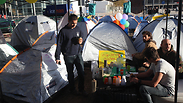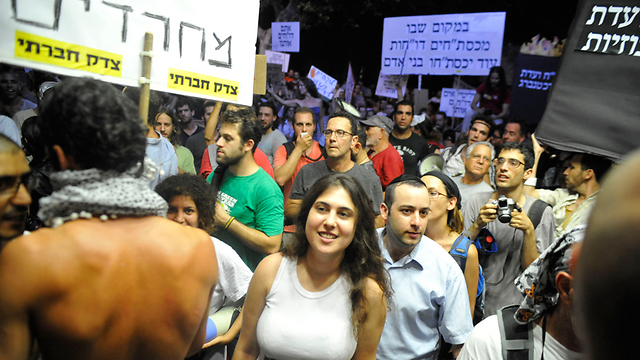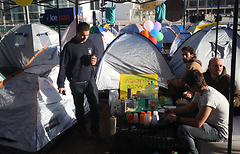
In June 2011 a 3.5–4 room apartment in Tel Aviv cost 2.4 million shekels, 50 percent more than in June 2006. Yogurt cost 3.3 shekels. A liter of gas—self service—cost 7.5 NIS. The gross average salary was 8,500 NIS.
Just like every year, in June 2011 Israelis prepared themselves for Shavuot by purchasing dairy products by the truckload. While doing his holiday shopping, a young ultra-Orthdox man named Itzik Elrov discovered that over the last five years the price of cottage cheese had grown from 4.90 shekels to 6.9, a 40 percent increase. Shocked and aggravated, he took to Facebook and called on the people of Israel to band together for an uncompromising fight over the prices of all types of spreadable white cheese. The public’s reaction was surprisingly robust, with many taking up the cause.
And so it was that exactly five years ago, the cottage cheese boycott began, which had morphed into the tents protest, which evolved into the Social Justice protest, which eventually amassed to hundreds of thousands of protestors demanding a new national priorities list, which then led to… What did it lead to, again? The Trajtenberg Committee, early elections, two more terms with Prime Minister Benjamin Netanyahu and the establishment of the Yesh Atid Party, which had inaugurated itself as the champion of that protest.
But who were the people doing all the protesting? The socio-economic demographic that made up the social justice protest remains a mystery, as Israeli sociologists failed to do their jobs and hit the streets in real time. No questionnaires were handed out, no samples were analyzed, no experiments were held. And so, we do not have any expert information on the demographic makeup of the multitudes of protestors, their ethnicity, political affiliation, economic status, or stance on various issues. Instead, we got emotional stories on and by the protests’ leaders and the thoughts of media pundits.
The one person who did have to evaluate the social protest in real time was Netanyahu. As prime minister, he identified its strengths and weaknesses. During its first wave, I heard Netanyahu talk about a three-pronged government move to satisfy and placate the protest and its protestors.
On the political level, there would be a newly established public committee helmed by an apolitical figure. On the economic level, a new train network running from north to south was announced. And on the housing level, hundreds of thousands of housing units were slated to be built in typically neglected urban areas. Netanyahu believed that the protests would go away if and when these projects would begin to be implemented.
It must have come as a surprise to Netanyahu when the protest dissipated even sooner than that, but, even so, he was worried. He warned against violent provocations by anarchists and the Left, but these never came about; The protest was run calmly and responsibly. As the daughters and sons of the upper middle class, the protestors did not misbehave, sexually harass, litter or disrupt social order.
They remained polite. Some see their restraint and lack of radicalism, or “niceness,” as the reason why the protest was unable to instigate political change. Its detractors say that being too cautious, too lost within its own hesitations is what turned the protest from a rebellion to a party, and from a scandal to a festival. Supposedly, the protest was killed with kindness.
Focused Achievements
I, however, have a different opinion. Personally, I feel that the protest did manage to achieve many of its initial goals, simply due to the fact that they were rather modest. Apart from a handful of more radical, left-wing socialists, the vast majority of the protestors were not looking to replace Israel’s form of government. Nor did they want a revolution. They identified a lot more with the first leg of the protest, which focused on consumerism, and a lot less with its socio-political second leg.
They did not relate to calls demanding to replace the government or to Trajtenberg’s resignation from the committee set up by Netanyahu to understand the motives behind the protest and find a way to calm it down. A statement made by one of the protest leaders, which called it “the most misleading, cruel and cynical committee in Israeli history,” only amounted to distancing herself and the rest of the protest’s spokespersons from the sentiments of the many people out there protesting. The people did not demand abstract social justice, but concrete social justice.
Journalist Asher Schechter followed the protest and even published a book on it. He considers the 350,000-person protest in front of the prime minister’s residence in August 2011 as its pinnacle and “moment of downfall.” From there until the protest on September 3, the leadership began to split apart. “As the tent encampment gradually becomes a fairground,” wrote Schechter. “the protest loses any political influence it might have had.” Press conferences quickly become “hellish disasters,” shouts to replace the government are not echoed by the general public, and the media—though sympathetic to the protest—grow tired of it.
When a speaker takes the stage at the “Million Person Protest” (which more accurately amounted to half a million all over Israel) and says, “A people that rises up will never again be seated,” she seems unaware that the people are tired of standing up in protest. Rather, the drained and sweaty people feel that it has accomplished enough. Schechter fittingly dubbed that protest as “an end-of-summer blowout party.”
Indeed, it turned out to be the beginning of the end. On September 9, the tent encampment quietly began to be evacuated. Acting with a swift efficiency, the Tel Aviv Municipality started cleaning up Rothschild Boulevard, setting up fences, planting grass, demarcating bike lanes, setting up lawn chairs and erecting jungle gyms. Was there ever a protest? A year later, a more violent attempt to restart it ends in tragedy; a last ditch effort to get it going again with the help of a propaganda-spreading TV show garners nothing but pitiful ratings.
And yet, the protest was not a failure. While the Arab Spring ended in a bloodbath and military dictatorships, Occupy Wall Street was converted into the driving force behind Donald Trump’s mass audience appeal and protests in Britain could not prevent a 500% increase in public university tuition the Israeli protest did comparatively well. Its achievements were modest, sparse and focused on the middle class, but they were still accomplished. It managed, for instance, to secure free education for all children aged 3–4, and not just for those coming from low income families. It attained tax benefits for young working families. It lowered prices on items such as sliced cheese, and cottage cheese was brought down to 5.70 shekels—a 17 percent decrease. The price of gas was also lowered to 6 shekels, constituting a 20 percent decrease (though not thanks to the protest, but due to US fracking). You could even chalk up the low-fee cellular company Golan Telecom to the protest’s achievements, though it did not focus on lowering cell phone bill costs.
During the summer of 2011, much was said on the need to alleviate some of the strain placed on the government’s social budget. It caught on, and was discussed at the supermarket, the bus stop. Back then, Israel was among the lowest ranked countries in the OECD, and as such the need to enlarge the social budget was supported by Trajtenberg, other members of his committee and a group of financial advisors headed by Prof. Yossi Zeira and Aviah Spivak. But the recommended budgetary increase never came about, and Israel’s OECD status remained as it was. In fact, a contradictory move was recently made by the government, which initiated and managed to pass an even lower “fiscal rule” that decides how much more the budget can be allowed to grow each year.
Without a real bridge
To fund the proposed social plans—most of which intended to help the already rather comfortable middle class—a raise in taxes was suggested. Always a supporter of lower taxes, Netanyahu begrudgingly accepted the terms of the proposal. Higher taxes on company profits, capital gains and high personal revenues were issued, yet the Finance Ministry’s tax gains did not reflect much of an increase. After being found inefficient, the tax raises were eventually canceled. Was it due to bad financial predictions? Someone shirking responsibility? These questions were never answered.Prof. Yossi Zera, you oversaw the financial advisory division regarding the protest and put together the main suggestions for a new (national) budget. Looking back five years on, did the protest fail or succeed?
“It did both.”
How so?
“On the one hand, it’s clear that the protest died out very quickly, about three months after it began. It was successfully neutralized, so to speak, by Netanyahu and the Trajtenberg Committee. On the other hand, its long-term effects may turn out to be significant.”
Could you give some examples of this?
“As a social protest, Occupy Wall Street seemingly ended with nothing to show for it. It died out. But it then returned to the political forefront thanks to Senator Bernie Sanders’ presidential campaign. He may not be the Democratic Party’s nominee, but he could very well impact the party’s platform by focusing on more liberal, left-wing issues. He may even start a new social democratic party, which would really be revolutionary.”
What was the main reason for the protest suddenly dying out?
“Internal struggles. The tent encampment in Tel Aviv was populated by the middle class that highlighted on the passing hardships they faced in their struggle for financial stability.”
Were they focused on finding employment and proper housing?
“Exactly. At the same time, though, encampments set up in more marginalized and neglected towns were filled with young women and men whose financial and social futures were almost completely blocked off, and who were severely disenfranchised. There was no attempt to bridge these two aspects of the protest.”
When asked what had prevented the Tel Aviv branch of the protest from adopting the demands of underdeveloped towns and the Arab sector, Zeira admitted that he does not have a definitive answer.
“Perhaps it was the fact that the protest came about so quickly,” he said. “Or maybe it was the government’s constant efforts to play both ends against the middle. Either way, it’s clear to me that it was this unnecessary internal rift that had paralyzed the protest at such an early stage.’
But while the protest itself has died out, its shadow continues to loom over the government, causing both the current and previous finance ministers to come up with creative ways to subsidize apartments for families. Former minister Yair Lapid (Yesh Atid) tried it with his 0 percent VAT plan, and current Finance Minister Moshe Kahlon (Kulanu) is trying it now with a plan of his own. Both initiatives were born out of the social protest.
The spirit of the protest exists within current regulations, in the Knesset and through media discourse. Some even relate the fight against the gas deal with business mogul Yitzhak Tshuva to it. But—and this is a big but—try to get 20,000 people to go out now and protest against government policy on matters relating to poverty. Currently, it just won’t happen.


















